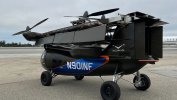NorthEast Ohio
Pre-takeoff checklist
- Joined
- Jul 4, 2020
- Messages
- 194
- Display Name
Display name:
NorthEast Ohio
- Northern Californian company Aska showed this prototype of a flying car during Monterey Car Week that it hopes to produce within two to three years.
- The Aska A5 flying vehicle can take off both vertically and horizontally, an improvement on the "flying car" idea.
- The plan is to use these planes as rentals or taxis, priced at around $800,000, and 100 prospective buyers have already placed reservations

Source: Aska Resurrects the Promise of a Flying Car




